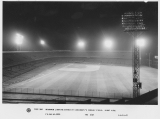
October 25, 2012 EAST CLEVELAND, Ohio — October 25, 2012 — (NYSE:GE) — The magical experience of baseball played under the lights may have been most aptly described by James T. Golden, Jr., a Cincinnati Enquirer sports writer. He wrote of the first Major League Baseball game played under lights in 1935, “…The sphere stood out against the sky like a pearl against dark velvet.” Night baseball is a special experience for fans—it’s literally a more electric atmosphere. Origins of the Night Game Just like a player’s trajectory, night baseball started in the minors. R.J. Swackhammer, a GE lighting designer, created the lighting layout for the first Minor League Baseball night game in 1930. Major League Baseball night games trace their roots to a struggling early 1930s Cincinnati Reds team, with average weekday game attendance floating between 2,000 and 3,000 fans. People were working during prime daylight hours and catching a baseball game rather than working was an oft-unaffordable splurge. Leland “Larry” MacPhail and Powel Crosley, the then-respective general manager and owner of the Reds, noticed a positive correlation between lights and attendance in Minor League Baseball parks. Despite the team’s financial woes, the Reds boldly decided to install lights at Crosley Field. They may not have known it at the time, but they sparked a lighting revolution in Major League Baseball. On May 24, 1935, the first night baseball game was played under GE lights with more than 20,000 fans in attendance—about 10 times the number that had been attending day games. For the seven games played under the lights at Crosley Field that first year, average attendance stood at 18,500 fans. It was a success that forever changed how baseball would be played and experienced. Red Barber, who announced the first Major League Baseball night game, observed, "As soon as I saw the lights come on, I knew they were there to stay." By 1941, just six years after the first Major League Baseball game was played under the lights, 11 of the 16 Major League Baseball fields had lights installed. During the 2012 regular season, the National League played 66 percent of its games at night, while the American League played 68 percent of its games at night. Innovations in Lighting Technology As other technologies advanced, so did the lighting used at baseball fields. With the rise of color television coverage, the original lights installed in many baseball stadiums (about 75-foot-candles of light output) were no longer adequate to light the fields and meet the new demands of broadcasters. At PNC Park in Pittsburgh today, for example, the GE stadium lights have an output of about 200 foot candles of light on the outfield and more than 300 foot candles of light on the infield, providing a crisp and clear night baseball game for all fans—those enjoying the game inside the stadium and those watching at home. The future of sports lighting continues to evolve. Today’s technologies and designs aim to provide better spill-light control, less maintenance and longer life. “As we look ahead, we need to do more than just meet the numbers on the specification,” says Rick Owen, a lead lighting designer for GE Lighting. Designing with Light While the technology is important, equally as important is tailoring the lights to fit different stadiums. The entire process, from planning to installation, can take about 24 months. “The most challenging process is coordinating the fixture locations to achieve the optimum lighting levels,” says Debbie Johnson, a lighting designer with GE Lighting, “There are many obstacles, like speakers, scoreboards and banners that must be considered in the final lighting solution.” The aiming process is the most time intensive part of completing the design. It can include 24-hour workdays for final adjustments and light level verification. "We crisscross the field so many times that we end up walking several miles throughout each day," adds Owen. About GE Lighting
GE Lighting invents with the vigor of its founder Thomas Edison to develop energy-efficient solutions that change the way people light their world in commercial, industrial, municipal and residential settings. The business employs 16,000 people in more than 100 countries, and sells products under the Reveal® and Energy Smart® consumer brands, and Evolve™, GTx™, Immersion™, Infusion™, Lumination™ and Tetra® commercial brands, all trademarks of GE. General Electric (NYSE: GE) works on things that matter to build a world that works better.




